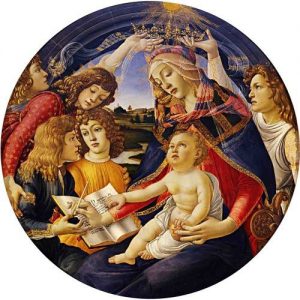
The Madonna of the Magnificat, by Italian Renaissance painter Sandro Botticelli, now in the galleries of the Uffizi, Florence. The Virgin Mary, crowned by two angels, is writing the opening of the Magnificat.
WelCom June 2017: October this year sees the 500th anniversary of the Protestant Reformation, which brought the Catholic Church into deep conflict and schisms. The Catholic Church today is not the same as the Church with which Martin Luther and the other Reformers came into such deep conflict. Luther wanted to reform his own church and not to split it. Many questions raised in the Reformation are still under discussion today. In his series, Kieran Fenn fms explores some of the key reformers of the sixteenth century, including Erasmus, Zwingli and Luther.
Martin Luther (1483–1546)
Martin Luther was bound to have a different approach to Mary from Zwingli as he was neither a pastor nor a chaplain, being a friar and a scholar trained in Scholastic theology. He preached on a number of feast days of Mary, her conception, birthday, assumption, purification, annunciation and visitation. His best work on Mary was his marvelous commentary on her Magnificat canticle, composed for the nephew of Luther’s chief protector, Duke Frederick the Wise of Saxony.
Mary’s Song (Luke 2:46–55)
From Mary’s song one should draw ‘Wholesome knowledge and a praiseworthy life’. One should hope also ‘to chant and sing it eternally in heaven’. Doctrinally the song strongly refers to Christ and the salvation he accomplished. Mary ‘sings most sweetly of the fear of the Lord, what manner of Lord he is, and especially what his dealings are with those of high and low degree.’ Devotionally, Luther does not hesitate to wish for Mary’s help: ‘May the tender Mother of God herself procure for me the spirit of wisdom, profitably and thoroughly to expound this song of hers.’ He prays, ‘May Christ grant us (this) through the intercession and for the sake of his dear Mother Mary.’
“It is precisely in her lowliness that ‘Mary is the foremost example of the grace of God’.”
The beautiful commentary on Mary’s prayer was written after his excommunication and his writing still was not yet affected by his growing polemic with his critics. The basic principles he still held to, begin with the insight Mary was of the descendants of a, by then, impoverished Davidic line (present insights would stress the Davidic ancestry was through Joseph). Mary was ‘but a simple maiden, tending the cattle and doing the housework, and doubtless esteemed no more than any poor maidservant today’. And yet Christ ‘is born of the despised stem, of the poor and lowly maiden’. Luther maintained the traditional doctrines of her virginity and her life: ‘She became a mother in a supernatural manner.’
Mary, Holy and Human
Mary’s song is the poetic and grateful record of her experience as Mother of the Saviour. She sang it to the glory of God, and ‘not for herself alone but for us all, that we should sing it after her’. Highly favoured by God though she is, Mary preserved her humanity and constantly confessed her low estate before God. This is one of the main points that Luther, writing to a prince, emphasised as he dwells on the notion that ‘humility is the highest of virtues’ ‒ something dear to Pope Francis as he puts before us the point that ‘clericalism is the cancer of the Church’. Like Luther, the pope reminds us one should not eliminate her lowliness and dwell only on ‘great and lofty things’ and attribute all kinds of merits to her. On the contrary, it is precisely in her lowliness that ‘she is the foremost example of the grace of God’.
Mary in her Magnificat not only tells us of what God has done in her; she praises God’s work in all humanity, ‘singing also for them’ and inviting us to sing with her. These divine works appear in the song as ‘mercy’, ‘exalting the lowly’, ‘filling the hungry with good things’, ‘sending the rich away empty’.
These were once described as a political, social, and economic revolution. To conclude her song, Mary sings of ‘the very greatest of all God’s work – the Incarnation of God’s Son’. Since this was done for the salvation of the whole world, Mary ‘acknowledges herself handmaiden and servant of all the world’. The world is symbolised here by Israel, at least by ‘that part of it that is God’s servant’.
Marian Piety
Luther was concerned that one can become so used to the Magnificat, sung daily and solemnly in the prayer of the church, Vespers, that one no longer properly appreciates it. He said, ‘The oftener we sing it the more we silence its true music and meaning’. ‘It needs to be pondered in the heart, what it means to be the Mother of God’. We should bless Mary in keeping with her prophecy, ‘all generations shall bless me’; ‘such a blessing is done with all one’s strength and downright sincerity, with the heart, moved by her low estate and God’s gracious regard for her.’
How well Luther anticipated our own times. The Conference of Latin American Bishops who said of Mary’s song, ‘It is an escape to interpret this at only a spiritual level!’ And the situation under a Latin American dictatorship when the praying of the Magnificat in public was forbidden; the powerful elite were possibly more aware of the challenge of the song than were those who prayed it without imbibing its call for justice to the poor and lowly.
Source: Tavard, George H. Collegeville (1996) The Thousand Faces of Mary. Michael Glazier: